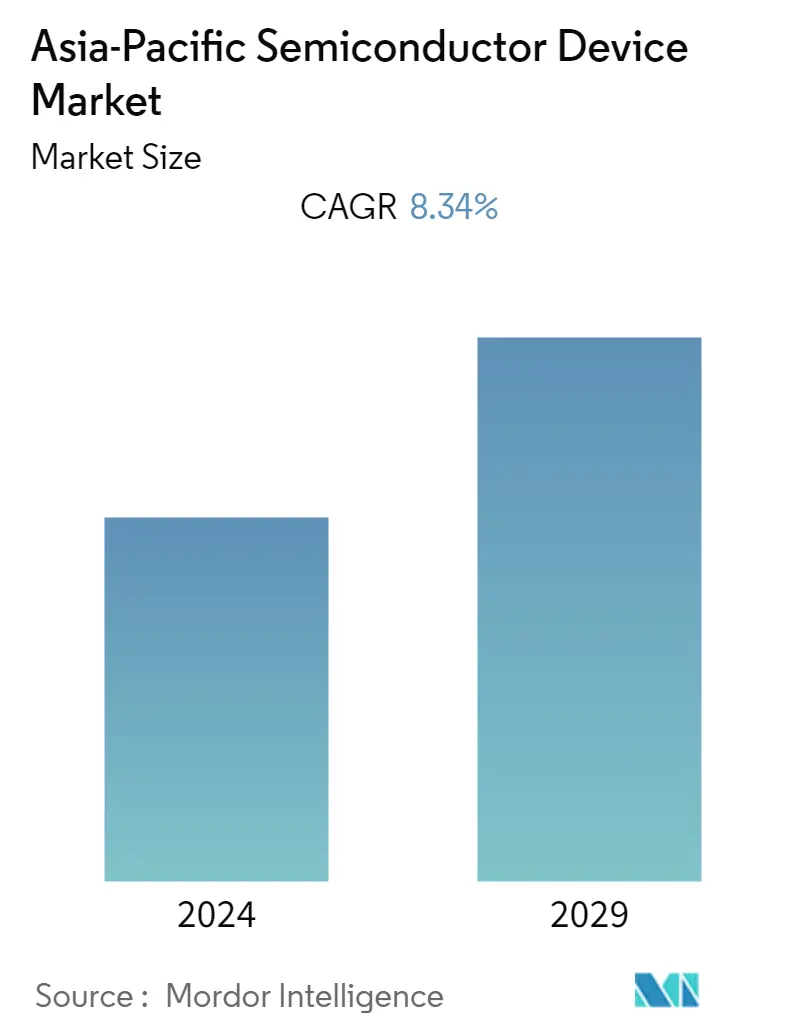Market Size of Asia-Pacific Semiconductor Device Industry

| Study Period | 2019 - 2029 |
| Base Year For Estimation | 2023 |
| Forecast Data Period | 2024 - 2029 |
| Historical Data Period | 2019 - 2022 |
| CAGR | 8.34 % |
| Market Concentration | Low |
Major Players*Disclaimer: Major Players sorted in no particular order |
Need a report that reflects how COVID-19 has impacted this market and its growth?
Asia-Pacific Semiconductor Device Market Analysis
The Asia-Pacific semiconductor devices market is expected to register a CAGR of 8.34% during the forecast period.
- The Asia-Pacific semiconductor market is valued at USD 430.24 billion currently and will likely become USD 695.73 billion by the next five years. The increasing demand for semiconductor devices from the electronics and automotive industries is expected to contribute significantly to revenue generation in the coming years; however, a shortage of skilled labor-intensive tasks may impede industry expansion in the coming years.
- In recent years, India has witnessed a significant surge in the usage of connected devices, including smart home devices and wearables. According to Cisco, India will have around 2.1 billion Internet-connected devices by 2023. The country is also expected to cross the 900 million mark of Internet users, according to the recently published Cisco Annual Internet Report (2018-2023), owing to the increased penetration of affordable smartphones and cheaper Internet plans. Demand for connected devices will drive the market's growth during the forecast period.
- In April 2023, Japan's trade minister pledged the government will increase its financial support for chipmaker Rapidus as it works to develop advanced semiconductors, claiming domestic production of such components is crucial for the country to excel in artificial intelligence and autonomous driving. The project is noticed as a quasi-public sector effort, with Rapidus becoming a potential national champion as the country tries to develop a robust local chip sector. The government contributed USD 530 million in financial aid for its launch.
- Moreover, Taiwan Semiconductor Manufacturing Co. and Sony Corp., in November 2021, announced that they would establish a USD 7 billion chip facility in Japan by the end of 2024. As trade tensions between China and the United States threaten to disrupt supply chains and demand for essential components grow, Sony Corp. has announced a USD 500 million investment in factories to provide chips to Japan's electronic device makers and auto businesses. Such investments are likely to boost the growth of the studied market.
- Further, the growing reliance on digital connectivity across various end-user industries has led to a sharp rise in data usage worldwide. For instance, according to Nokia's annual Mobile Broadband Index (MBiT) report, the average data consumption per user in India reached 19.5GB per user a month in 2022, equivalent to 6,600 songs. Mobile data traffic in India jumped 3.2 times in the last five years, reaching over 14 exabytes per month towards the end of 2022. Increased online education, work-from-home model, and higher over-the-top (OTT) viewership increased data traffic. Such factors are aiding the growth of the market for data centers.
- Conversely, the semiconductor industry faces various challenges in developing and producing semiconductor devices. A major challenge is that as transistors continue to get smaller, maintaining the same performance and reliability becomes more challenging. Further, due to the high complexity of modern semiconductor devices, there is a need for efficient heat dissipation. Issues with thermal management can lead to reduced device lifetime and performance. However, variability among individual devices is prevalent in semiconductor manufacturing and can lead to problems with yield and reliability.
- The COVID-19 pandemic significantly impacted the semiconductor devices market. The industry faced several supply chain issues, price fluctuations, and the availability of raw materials. According to the Semiconductor Industry Association, the semiconductor industry began its recovery after Q1 of 2020. Despite logistical challenges related to COVID-19, semiconductor facilities located in Asia-Pacific continued to function normally with high-capacity rates.
